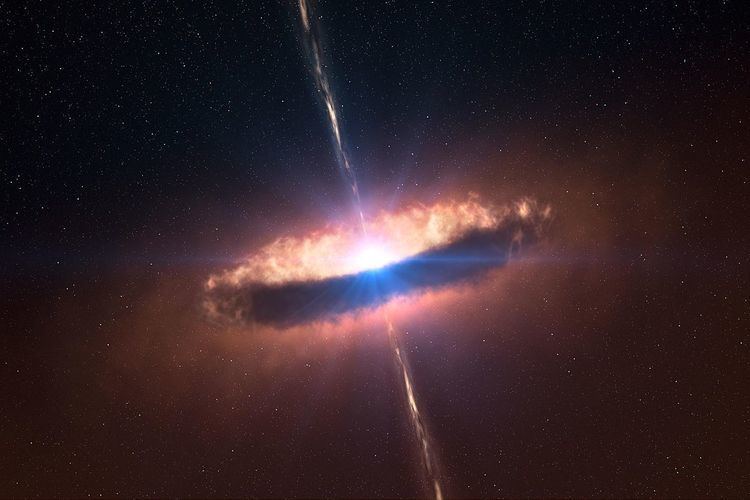 | ||
This is a list of the most massive stars so far discovered, in solar masses (M☉).
Contents
Uncertainties and caveats
Most of the masses listed below are contested and, being the subject of current research, remain under review and subject to revision. Indeed, many of the masses listed in the table below are inferred from theory, using difficult measurements of the stars’ temperatures and absolute brightnesses. All the listed masses are uncertain: both the theory and the measurements are pushing the limits of current knowledge and technology. Either measurement or theory, or both, could be incorrect. For example, VV Cephei could be between 25–40 M☉, or 100 M☉, depending on which property of the star is examined.
Massive stars are rare; astronomers must look very far from the Earth to find one. All the listed stars are many thousands of light years away and that alone makes measurements difficult. In addition to being far away, many stars of such extreme mass are surrounded by clouds of outflowing gas; the surrounding gas interferes with the already difficult-to-obtain measurements of stellar temperatures and brightnesses and greatly complicates the issue of estimating internal chemical compositions. For some methods, different determinations of chemical composition lead to different estimates of mass. In addition, the clouds of gas make it difficult to judge whether the star is just a single supermassive object or, instead, a multiple star system. A number of the "stars" listed below may actually consist of two or more companions in close orbit, each star being massive in itself but not necessarily supermassive. Other combinations are possible – for example a supermassive star with one or more smaller companions or more than one giant star. Without being able to see inside the surrounding cloud, it is difficult to know the truth of the matter. More globally, statistics on stellar populations seem to indicate that the upper mass limit is in the 100-200 solar mass range.
Amongst the most reliable listed masses are those for the eclipsing binaries NGC 3603-A1, WR21a, and WR20a. Masses for all three were obtained from orbital measurements – for a binary star, it is possible to measure the individual masses of the two stars by studying their orbital motions, using Kepler's laws of planetary motion. This involves measuring their radial velocities and also their light curves. The radial velocities only yield minimum values for the masses, depending on inclination, but lightcurves of eclipsing binaries provide the missing information: inclination of the orbit to our line of sight. Therefore, the masses of eclipsing binaries are the sole ones to be derived with some accuracy.
However note that the table below mostly lists masses derived by indirect methods, and only a few masses derived for eclipsing systems.
Relevance of stellar evolution
Some stars may once have been heavier than they are today. It is likely that many have lost tens of solar masses of material in the process of degassing, or in sub-supernova and supernova impostor explosion events.
There are also – or rather were – stars that might have appeared on the list but no longer exist as stars. Today we see only the debris (see for example hypernovae and supernova remnant). The masses of the precursor stars that fueled these cataclysms can be estimated from the type of explosion and the energy released, but those masses are not listed here.
List of the most massive stars
A few stars with an estimated mass of 25 or greater M☉, including the stars of Arches cluster, Cygnus OB2 cluster, Pismis 24 cluster and R136 cluster. Note that all O-stars have masses > 15 M☉ and catalogs of such stars (GOSS, Reed) contain hundreds of cases. Masses quoted below are their current (evolutionary) mass, not their initial (formation) mass. The list is very far from complete, especially below 80 M☉—although the majority of stars thought to be more than 100 M☉ are shown. Method is provided to get an idea of uncertainty—direct methods (binarity) being more secure than indirect ones (conversion form luminosity, extrapolation from atmosphere models,...).
A few additional examples with masses lower than 80 M☉.
Black holes
Black holes are the end point evolution of massive stars. Technically they are not stars, as they no longer generate heat and light via nuclear fusion in their cores.
Eddington's size limit
The limit on mass arises because stars of greater mass have a higher rate of core energy generation, their luminosity increasing far out of proportion to their mass. For a sufficiently massive star the outward pressure of radiant energy generated by nuclear fusion in the star’s core exceeds the inward pull of its own gravity. This is called the Eddington limit. Beyond this limit, a star ought to push itself apart, or at least shed enough mass to reduce its internal energy generation to a lower, maintainable rate. In theory, a more massive star could not hold itself together, because of the mass loss resulting from the outflow of stellar material. In practice the theoretical Eddington Limit must be modified for high luminosity stars and the empirical Humphreys Davidson Limit is derived.
Astronomers have long theorized that as a protostar grows to a size beyond 120 M☉, something drastic must happen. Although the limit can be stretched for very early Population III stars, and the exact value is uncertain, if any stars still exist above 150-200 M☉, they would challenge current theories of stellar evolution. Studying the Arches cluster, which is currently the densest cluster of stars in our galaxy, astronomers have confirmed that stars in that cluster do not occur any larger than about 150 M☉. One theory to explain rare ultramassive stars that exceed this limit, for example in the R136 star cluster, is the collision and merger of two massive stars in a close binary system.
